Fig. 18.1
Examples of accessories not to wear. (a) Necklaces worn during surgery might break or contact the surgical wound. (b) Watches can damage gloves
Solution
Remove accessories and external apparel that do not serve a functional purpose before entering the sterile field. Secure identification badges to prevent their contact with the sterile field or equipment.
Gloves
Accidents Happen When
Gloves are inappropriately selected for a given task.
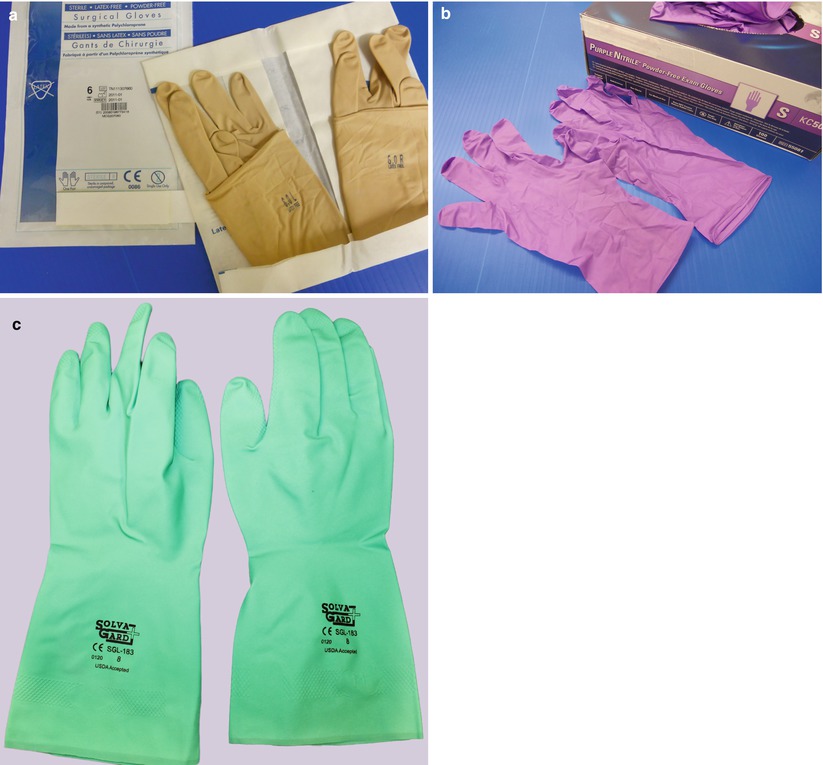
Fig. 18.2
Gloves used in the health care setting are classified into three main types. (a) Sterile gloves are used for surgery. They are disposable, sterile, individually wrapped items and come with or without powder. (b) Non-sterile gloves are single-use gloves used to protect against direct skin exposure to blood and other body fluids and for anticipated contact with mucous membranes or contaminated equipment/surfaces. They come as latex, latex-free, vinyl, neoprene, or nitrile. (c) Utility or heavy-duty household gloves are used for handling contaminated items and waste and for cleaning contaminated surfaces (e.g., used by janitorial staff). They can be reused after decontamination, but they should be discarded when punctured or torn
Accidents Happen When
Expired or deteriorated gloves are used.
Solution 1
Inspect gloves for signs of deterioration, such as brittleness, tackiness, or an acid chemical odor, and discard if any abnormalities are noted.
Solution 2
Remove gloves from their box in a “last in, first out” fashion. That is, do not push aside the outermost glove to take from the middle of the box.
Accidents Happen When
Gloves are stored in areas where there are extremes in temperature (e.g., in the sun, near a heater, air conditioner, ultraviolet light, fluorescent light or X-ray machines), causing breakdown of the glove material.
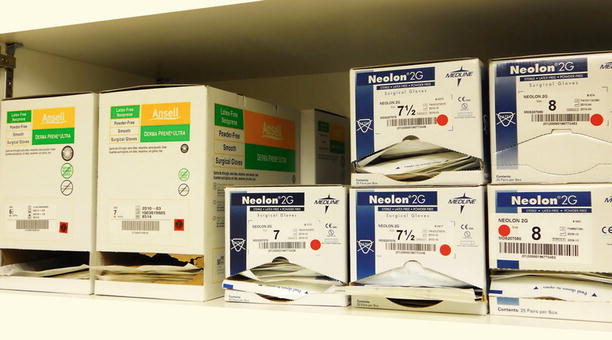
Fig. 18.3
Proper storage of gloves
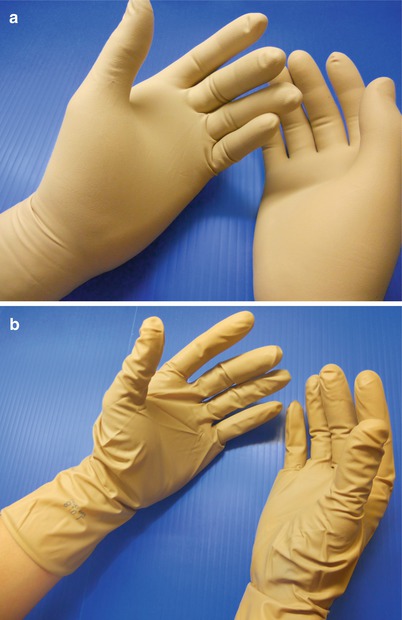
Fig. 18.4
Improperly sized gloves. (a) Gloves are too tight, limiting dexterity and tearing more easily. (b) Gloves are too loose, impairing instrument handling
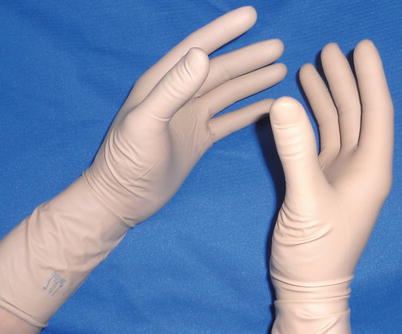
Fig. 18.5
Gloves fit properly
Accidents Happen When
Gloves are torn during surgery, potentiating exposure to blood and body fluids.
Solution 1
Remove damaged gloves, wash hands, and use new gloves immediately.
Solution 2
Trim fingernails to less than 3 mm or 1/8 in. beyond the fingertip to reduce the risk of tears.
Accidents Happen When
Contaminated gloves are worn for prolonged periods of time. Transmission of hepatitis B and hepatitis C virus between patient and healthcare worker has occurred with apparently intact gloves [1]. Latex gloves exposed to fat lose their integrity. Gloves can also develop unapparent tears over time (Table 18.1).
Less than 1 h | 13 % |
1 to 3 h | 27 % |
3 to 5 h | 47 % |
Over 5 h | 58 % |
Solution
Change surgical gloves every hour.
Controversial Point:
Double gloving.
Pros
Penetration through the inner glove is reduced with double gloving. The risk of contamination from blood borne pathogen exposure is decreased by 70 % when using two pairs of gloves [2, 3]. If double gloving is used, the inside glove should be a half size smaller than the outside glove to create an air cushion, reducing hand and wrist constriction. Practitioners may need time to become comfortable performing procedures with double gloving.
Cons
In surgery where delicate manipulation of instruments and tissues is required, double gloving may reduce tactile sensation.
Accidents Happen When
Hands are not washed after removing gloves. Contaminants come into contact with the skin and mucous membrane when removing gloves.
Solution 1
Always wash hands after glove removal. Gloves may have barrier defects that are not visible to the naked eye [4].
Solution 2
Avoid skin contact when removing gloves.
Solution 3
Avoid “snapping” the glove upon removal as this may cause contaminants to splash.
Accidents Happen When
Latex gloves are used by staff members or patients with a history of latex allergy.
Solution
Only stock and use non-latex (e.g., nitrile, neoprene, vinyl) gloves. Gloves labeled “hypoallergenic” should not be assumed to be latex-free.
Surgical Attire
Accidents Happen When
Scrub suits are worn inappropriately. An ill-fitting top exposes chest hair. A non-tucked top risks inadvertent field contamination (Fig. 18.6).
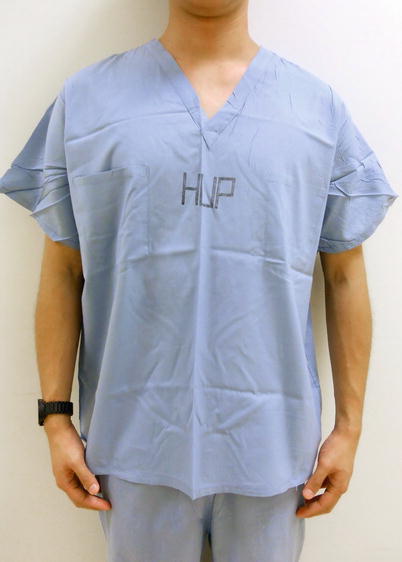
Fig. 18.6
Ill-fitting scrub top
Solution
Scrub suits should fit the body snugly (Fig. 18.7). Change scrubs as soon as possible whenever they become wet or visibly soiled.
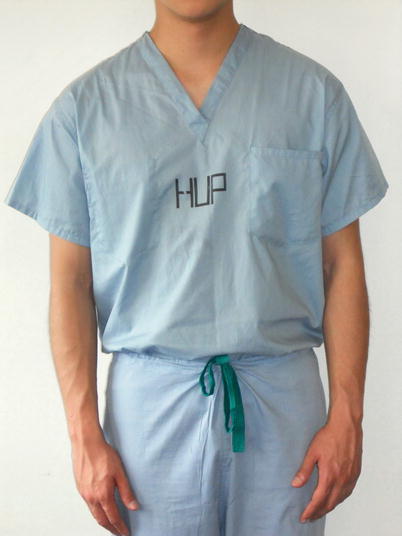
Fig. 18.7
Scrub top properly tucked and secured at the waist
Accidents Happen When
Dark surgical attire is worn.
Solution
Surgical attire should be light in color in order to expose dirt and contamination easily (Fig. 18.7).
Accidents Happen When
Wrists are exposed when surgical gown is worn (Fig. 18.8). Also, large, droopy sleeves invite accidental contamination.
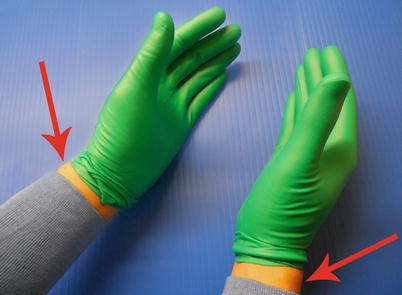
Fig. 18.8
Exposed wrists (red arrows)
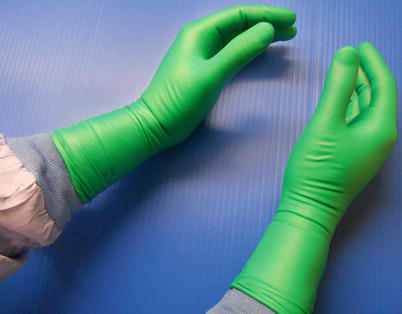
Fig. 18.9
Gloves pulled up over cuffs of gown protect the wrists









